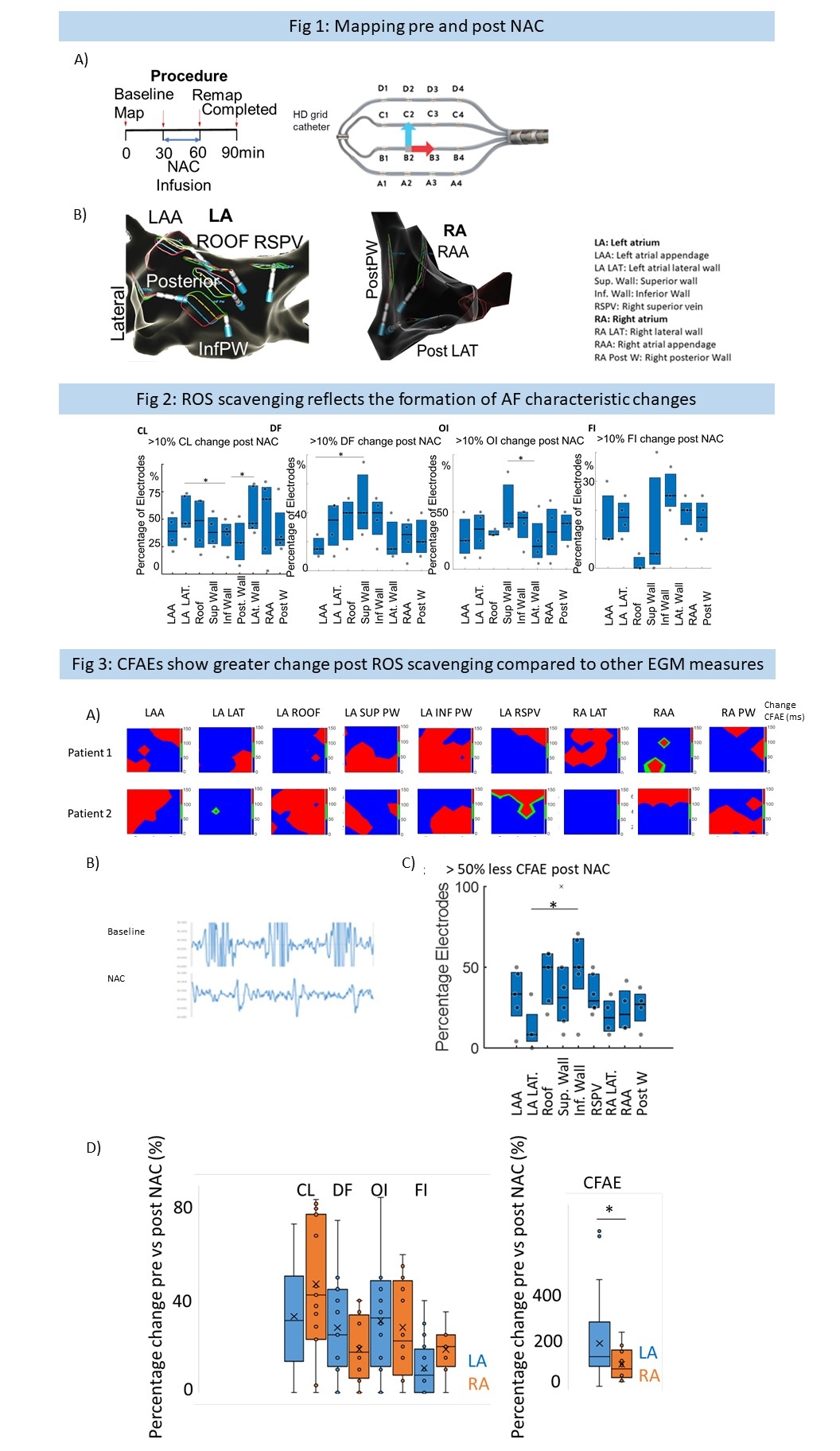Final ID: Sa2108
Reactive Oxygen Species Scavenging Reduces Complex Fractionated Atrial Electrograms (CFAEs) In Persistent Atrial Fibrillation Patients - A New Smart Mechanism Guided CFAE Targeting Approach in Atrial Fibrillation
Abstract Body (Do not enter title and authors here): Background
It is known that oxidative stress (OS) and complex fractionated atrial electrograms play an important role in AF. However, the effect of reactive oxygen species (ROS) on complex fractionated atrial electrograms (CFAEs) in persistent atrial fibrillation patients remains unsettled. While previous CFAE ablation studies have mixed results, it is currently also unclear which types of CFAEs should be targeted with ablation during the clinical electrophysiological (EP) study.
Objective
We hypothesized that ROS are dynamically involved in the creation of a vulnerable substrate leading to overlying CFAEs and that regions of CFAEs that may reflect high OS are uniquely sensitive to acute ROS scavenging with N-acetylcysteine (NAC) in persistent AF patients.
Methods
We performed in 5 patients with persistent AF high-density mapping in the left and right atrium (LA, RA) pre/post-NAC (intravenous, dose 100mg/kg) (Figure 1A) using the HD-grid catheter (EnSite, Abbott) (Figure 1B). We analyzed cycle length (CL) and dominant frequency (DF), organization index (OI), fractionation index (FI), and regions demonstrating >10% change in these parameters and CFAEs (definition EnSite) >50% change post-NAC.
Results
NAC (Figure 2) affected AF electrogram measures in atrial sub-regions, increasing CL in the left lateral free wall, right atrial free wall, affecting DF/OI preferentially in the left atrial superior wall and CFAEs (Figure 3A, B) in the left atrial inferior wall (Figure 3C). Acute administration of NAC caused significantly greater percentage changes in CFAEs in the LA (165%) pre vs post-NAC compared to percentage changes in CL (40%), DF (33%), OI (37%) and FI (16%) (P=0.002) (Figure 3D). 35% of all CFAEs in the LA and 21% in the RA were sensitive (>50% change, P=0.02) to ROS scavenging.
Conclusion
Acute administration of NAC organizes AF electrogram characteristics in subregions in the left and right atrium and has a greater effect on CFAEs in the left atrium compared to other established AF electrogram characteristics. About one third of all CFAEs are ROS dependent. These uniquely sensitive CFAE regions to ROS scavenging may constitute a new smart therapeutic target in patients with persistent AF.
It is known that oxidative stress (OS) and complex fractionated atrial electrograms play an important role in AF. However, the effect of reactive oxygen species (ROS) on complex fractionated atrial electrograms (CFAEs) in persistent atrial fibrillation patients remains unsettled. While previous CFAE ablation studies have mixed results, it is currently also unclear which types of CFAEs should be targeted with ablation during the clinical electrophysiological (EP) study.
Objective
We hypothesized that ROS are dynamically involved in the creation of a vulnerable substrate leading to overlying CFAEs and that regions of CFAEs that may reflect high OS are uniquely sensitive to acute ROS scavenging with N-acetylcysteine (NAC) in persistent AF patients.
Methods
We performed in 5 patients with persistent AF high-density mapping in the left and right atrium (LA, RA) pre/post-NAC (intravenous, dose 100mg/kg) (Figure 1A) using the HD-grid catheter (EnSite, Abbott) (Figure 1B). We analyzed cycle length (CL) and dominant frequency (DF), organization index (OI), fractionation index (FI), and regions demonstrating >10% change in these parameters and CFAEs (definition EnSite) >50% change post-NAC.
Results
NAC (Figure 2) affected AF electrogram measures in atrial sub-regions, increasing CL in the left lateral free wall, right atrial free wall, affecting DF/OI preferentially in the left atrial superior wall and CFAEs (Figure 3A, B) in the left atrial inferior wall (Figure 3C). Acute administration of NAC caused significantly greater percentage changes in CFAEs in the LA (165%) pre vs post-NAC compared to percentage changes in CL (40%), DF (33%), OI (37%) and FI (16%) (P=0.002) (Figure 3D). 35% of all CFAEs in the LA and 21% in the RA were sensitive (>50% change, P=0.02) to ROS scavenging.
Conclusion
Acute administration of NAC organizes AF electrogram characteristics in subregions in the left and right atrium and has a greater effect on CFAEs in the left atrium compared to other established AF electrogram characteristics. About one third of all CFAEs are ROS dependent. These uniquely sensitive CFAE regions to ROS scavenging may constitute a new smart therapeutic target in patients with persistent AF.
More abstracts on this topic:
Comparing 1-Year and 3-Year Outcomes of Atrial Fibrillation Ablation
Srivastava Viren, Clopton Paul, Brodt Chad, Narayan Sanjiv, Deb Brototo, Chang Hui Ju, Ganesan Prasanth, Brennan Kelly, Feng Ruibin, Rogers Albert, Baykaner Tina, Wang Paul
Differentiating Local from Global Repolarization Changes During Intra-Cardiac Mapping: The Inception of a Novel Mapping TechnologySubha Tasnia, Nanthakumar Kumaraswamy, Masse Stephane, Abderrahman Yusuf, Lai Patrick, Asta John, Bhaskaran Abhishek, Chakraborty Praloy, Chauhan Vijay, Dorian Paul

